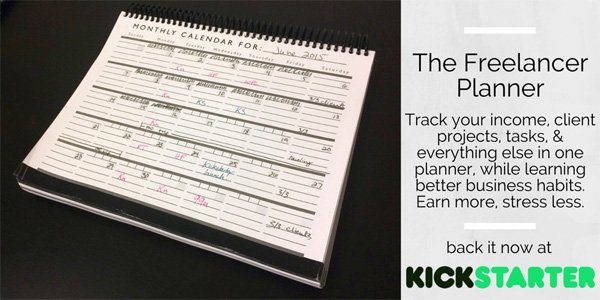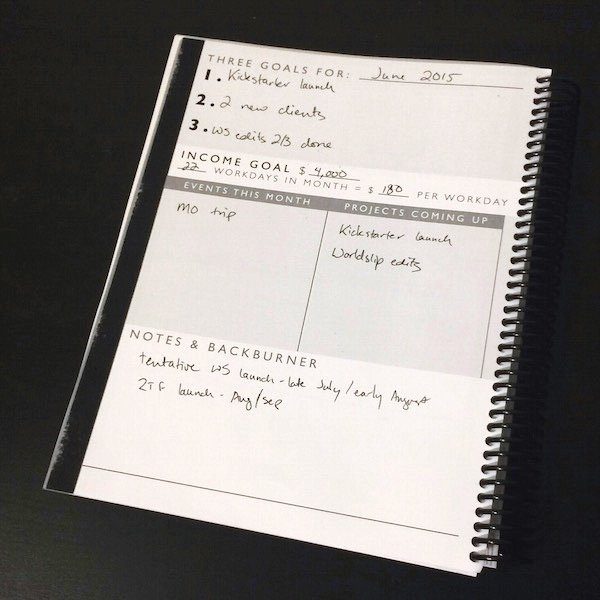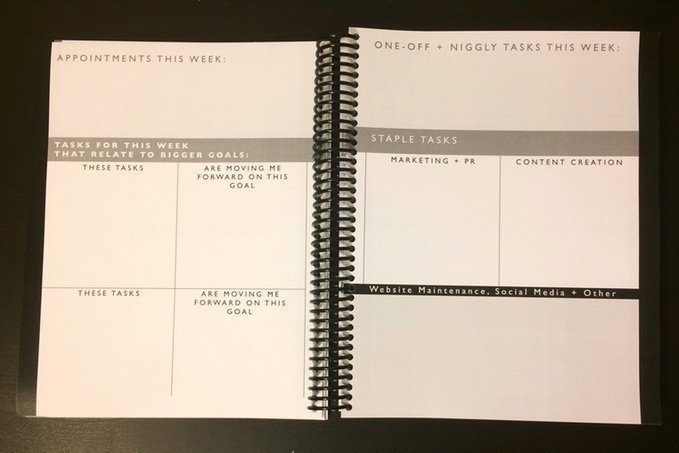How many of us can honestly say that we feel like we manage our time the way we’d like to? Most likely, very few (if any) of us actually feel that way. But that’s okay! This whole time management thing is not easy to get a grip on. As entrepreneurs, we have so many ideas, tasks, and projects constantly planned that it often feels like we need more hours in a day. Sure, most of us (everyone should!) use a planner, but is it really doing what we want it to? Michelle Nickolaisen wasn’t satisfied with the traditional planner, so she decided to create The Freelancer Planner. This re-imagined and improved take on the planner we’re used to not only helps improve our time management skills, but it also makes us BETTER as we work! Michelle can explain it better than anyone, so continue reading to find out how and why she decided to create this incredibly useful tool. Make sure you check out Michelle’s Kickstarter for The Freelancer Planner to get even more details, as well!

Allyn Lewis: Tell me about your background and what led you to create The Freelancer Planner?
Michelle Nickolaisen: There’s sort of two sides to this story. Side one is that I’ve been freelancing for most of my adult life and I’ve done a few different angles on self-employment/freelancing during that time. At the end of 2013, I got horribly burned out and wound up going back into a “real” job for 6 months or so. Due to a couple of different factors I decided to go back to freelancing, but I knew I needed to approach it differently this time. Since I had a little bit of space (that’s so hard to get when you’re in the day-to-day thick of it) I put my systems-brain to work on what I should do and keep track of to make my return to freelancing easier. I found myself hacking moleskines and DIYing printables so that I could keep track of what I needed to keep track of, and I just knew that other freelancers had to have similar problems and that we all needed a way to make this stuff easier. Side two of that is that I’ve been selling printable planners for creative freelancers/solopreneurs at Bombchelle since winter of 2011. When I had the idea for the Freelancer Planner, I took a lot of my inspiration from those original planners and used them as a framework to add onto and build out from.
AL: There are a million planners out there. What makes this one different?
MN: What most other planners have in common is that they basically give you a space to write things down, and that’s it. They can be well designed and nice to look at, and be specially formulated for the kind of life you have, but most of them don’t actually change the way you work. The Freelancer Planner, on the other hand, is designed to train you to work better as you use it. It doesn’t just give you a space to write things down, it helps you figure out what actually needs to be written down and where it should go in your week/workday and why.
AL: So, this isn’t just a planner? Your goal is to train freelancers to develop more efficient business habits. How will using your system do that?
MN: Like I said, the planner doesn’t just give you a place to write things down, but guides you to know what you should write and how that will affect your plans. For example, on the monthly level, the planner prompts you every month to not just set an income goal, but break it down into a daily number based on the number of workdays in the month. Then, you can use the monthly calendar view to keep track of where your income is actually at for the month, so you know if you need to step up your hustle more or not. The monthly calendar view also lets you keep track of client bookings – one of the bad habits freelancers have is saying yes to everything, which leads to burnout and to not having enough time to work on their own businesses, which then keeps them stuck in the feast or famine cycle. The planner will come with a guide in the beginning that walks you through how to figure out how much time you actually have for clients each week, and then book yourself out accordingly – no more overworking one week and having no clients the next.
Each week, there’s a planning process that helps you relate your tasks back to bigger goals, which keeps you working on your own business and creative fulfillment. As freelancers, we tend to prioritize client work above everything else, which is great for our clients, but often makes our own businesses suffer as a result. It also has space for tasks that fall under content creation, marketing, social media, website maintenance, etc., making sure nothing slips through the cracks. Then, the guide walks you through how to plan your weeks, based on what categories the tasks fell in when you went through that process. On each day, you’ve got a space for three priorities, to keep you focused, and there’s room for notes and backburner items that you can move into the forefront on the next week or month.
AL: You’re obviously awesome at time management given that you’re developing this planner while also maintaining your own freelance business. Other than using The Freelancer Planner, of course, what are your top three tips for business owners to manage their schedules?
MN: 1. Block out time for your own business! This is so important and so many freelancers/business owners are bad at it. I block out Mondays and Fridays for my own business – things like blog posts, administrative work, email, marketing, etc. all go on those days. You don’t have to do days of the week, but just make sure you are setting aside time on a regular basis to work on your business vs. working on client projects.
2. Batch tasks. If you have a bunch of administrative tasks to do, for example, then do all of them at once – don’t scatter them throughout the workday. Answering emails is another example of this. Don’t be in and out of your inbox throughout the day – check and reply to emails all at once. I go through my whole inbox and get down to inbox zero on Mondays and Fridays, and answer any important emails or client emails all in one go during the evening. If you put similar tasks together, you’ll get so much more done. (I have more about this here in a post about how I boosted my daily wordcount by 60%.)
3. Don’t have meetings first thing in the morning (and really, minimize meetings in general if you can). If you’re more productive in the afternoon, then swap morning for afternoon here. For me, mornings are when I do most of my creativity-heavy work and are when I’m most productive, so putting a meeting in the middle of the morning totally tanks my productivity for the day. Batching meetings (by putting them as close together as possible) is a good idea, too, because we all know that when there’s that awkward 45-minute block between meetings we’re not likely to actually do anything during it. As an introvert, I generally find meetings draining, so I try to minimize them as much as possible.
AL: What is your favorite part of being a freelancer?
MN: The flexibility! I’m a super independent person and I like having control over my workflow and how/when/where I work. I like that I can work a little less, still make a decent living, and have plenty of time to work on my creative side projects. And being able to sleep in when I need to (I’ve been sick a lot lately, so I very much appreciate this freedom) and work with my dog nearby certainly doesn’t hurt, either.
AL: If you could have given yourself a piece of knowledge or advice when you started, what would that be? Which opportunities should you have followed; what pitfalls would you have avoided?
MN: Oh wow! So many things to say! I think the main thing I’d tell myself is, if you’re going to work for cheap, do it with a goal in mind. When I originally started, I did a lot of work with content mills (which are sites that connect you to clients or create content that’s supposedly optimized for search engines in big batches of articles). I was a decent writer, I just had no idea where to actually go to get gigs, so I used them to get started. The problem was that I wasn’t doing this with plans of building a portfolio or moving on to bigger and better clients, I was just desperate and trying to make ends meet. I write really fast, but even for me, I couldn’t sustain the volume that I needed to for very long, so I burned out quickly and moved on to doing other forms of freelance work. Now I’m back to writing, and although I don’t really regret any part of my journey, I look back and see that I probably could have drastically shortened it if I had only done my starter work a little more strategically!
AL: Where do you see yourself and your business 5 years from now?
MN: Aside from writing, I’m not 100% for sure! I’d like to eventually expand into doing a whole line of printed planners/paper tools for freelancers and creative professionals. I know I want to keep writing and teaching, and expand into writing other things. For example, I’m working on a novel right now that’s the first in a trilogy (I hope to release it sometime next month – the launch date is a little loose since I’m currently working on it around doing the Kickstarter and a full client workload).
AL: What’s your favorite metaphor for describing entrepreneurship?
MN: Ha, I don’t know if it’s the healthiest metaphor, and it probably says more about me and the way I do things than entrepreneurship in general. But I’ve described it more than once as running full-force into a brick wall over and over again, until the brick wall eventually gives way. When it breaks down, you feel like a total badass…but it’s less fun while you’re running into the wall. 😉




